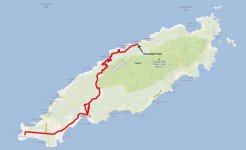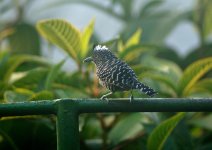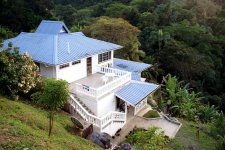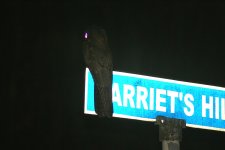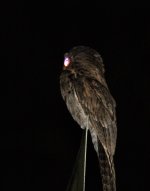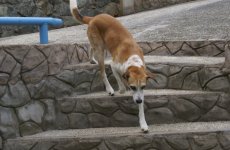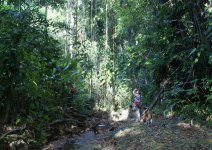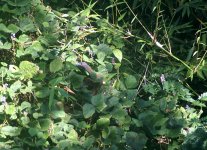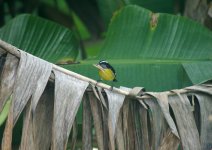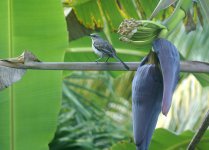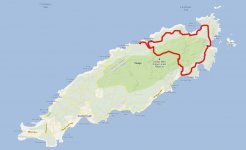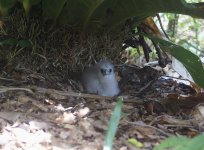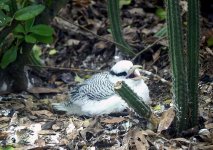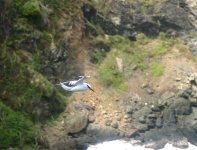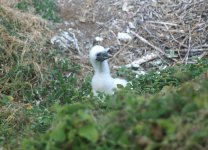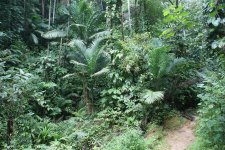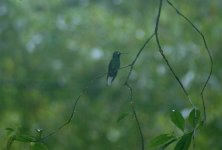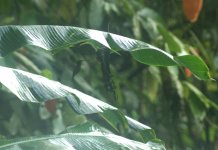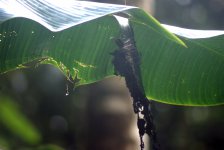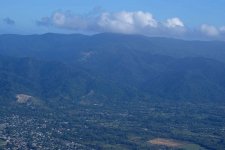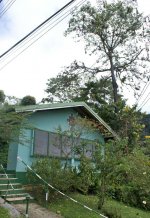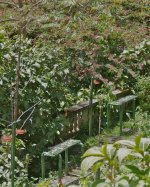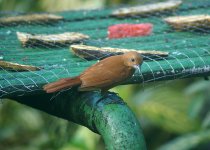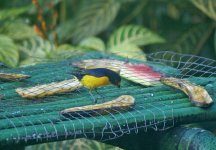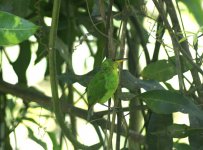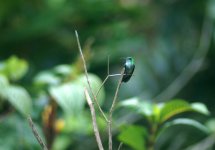Day1: Trindad, then Tobago (part the second)
The owners of Gloucester Place had asked us, via email, to phone them prior to our arrival. So, on our way there, we stopped in the little resort/fishing town of Castara to hunt for a phone. That search proved to be fruitless, but we did take the opportunity to stock up on a few groceries for the next few days. More significantly, we parked by the local soccer field, which turned out to be quite a birdy place; it had a creek along one side, and some good forest in behind it. The Blue-gray Tanagers were the first birds we noticed, but there was also a Green Kingfisher in the creek, White-tipped Doves foraging in the undergrowth (with the local chickens), and a couple of Pale-vented Pigeons sharing a dead tree with a Red-crowned Woodpecker. Best of all was a male Barred Antshrike - a truly bizarre-looking thing, and seemingly out of place in this almost suburban setting. Castara is also a good site (along with just about any bay in Tobago, I guess) for the Magnificent Frigatebird - there were many patrolling the skies as we drove up.
Not finding a ‘phone, we just drove on to GP and hoped for the best. We got there in the early afternoon; fortunately, the owners were in, and very welcoming to us, even though we’d showed up about six hours early. GP is a very modern house, set into a hillside high above the Caribbean. This situation has both advantages and disadvantages; on the plus side, the view is very good, and the house catches cooling breezes; on the down side, there is no easy access to the shore – theoretically, it was possible to walk to the beach in the town of Parlatuvier (less than a km. away) but it would be a heck of a climb to get back home again.
Our room looked out onto a long hedge of so-called “Firecracker bushes” named for their masses of small, tubular red flowers. The bushes were only about 1 m. from our windows, and were full of birds. Mostly these were the ubiquitous Bananaquits, but also the occasional hummingbird and (Tropical) Mockingbird. The hummers in these bushes were a real challenge to ID at first, as they didn’t seem to have any particular colour. In the end, we figure out they were Coppery-rumped, although they never seemed to get as colourful as the field guide showed them, even when seen in good light.
[Aside] Ah, yes, the Bananaquit, Coereba flaveola. You’ll want to get to know them well, if you’re going to Tobago, especially the various songs/calls – mostly, so you begin to filter them out. This is an attractive, well-adapted, admirable species, no doubt -- but here on Tobago, we couldn’t help but find them more than a little irritating in their very ubiquity. When one is trying to bird a large garden full of fruiting trees and flowering shrubs, and the bird life therein is about 93.5% Bananaquit, it can make the other 6.5% a little hard to see… [/aside]
From a bird-watching perspective, it is the grounds at GP that are its strong suit; in addition to all the flowering bushes and banana plants, there are a number of large fruiting trees that attract a whole host of birds; again, these were mostly Banaquits, but we were sure they’d have other goodies, it we just watched patiently. However, having gone the last 32 or so hours without a heck of a lot of sleep, we weren’t in much of a mood for watching much of anything, patiently or otherwise. After a quick dip in the (very scenic) pool, we went for a long nap, not emerging until late afternoon, at which point it was time to go foraging for dinner.
[Aside] Travellers’ tip: One of the charms of an area like Parlatuvier is the (relative) lack of development; not much here in the way of what is euphemistically referred to as “tourist infrastructure.” But this does mean that, for the visitor, finding a meal when you need one can be a bit of a challenge. Now, don’t mistake me – if the choice comes down to having Poulet Frit Kentucky, Pizza Shack and Planetbucks on the main street, or keeping it the way it is now, I would most definitely choose the latter; but the lack of these “tacky conveniences” here does mean that getting a meal does require some forethought (and often a bit of driving).[/aside]
Since we had no means (or material) for making our own dinner, this meant a trip (the first of many) to Castara, about 8 km back down the road we’d driven this morning. One the way, we took a very short diversion down to the beach at a place called Englishman’s Bay; we paused there partly to look at the bay as a potential snorkelling spot for the next day, and partly because we’d read about a good roti shack there, called Eula’s. Well, the sea looked to rough to be good for snorkelling, and Eula’s turned out to be open for lunch only, but the trip wasn’t all for nothing; just as we were leaving, DMM spotted a rather large bird underneath a large stand of bamboo just behind the restaurant – our first Trinidad Motmot (recently split from Blue-crowned). It was standing on the ground, pecking at something, god knows what it was finding to eat there…
In any event, it was now getting on towards sunset, so we left our Motmot to his dinner and continued on to Castara for ours. Plenty of places to eat there (and all locally-owned, thank goodness), but it seemed to us that they all offered the same menu: dinner. You can get the chicken dinner, the fish dinner, or maybe the shrimp dinner, but those are it for choices. Fortunately, it’s all quite good. After dinner, we hopped into our Chinese-speaking friend, and steered her back towards GP in the pitch dark. Luckily for us, the road here is in very good shape, and only sparsely travelled, so driving at night is not at all a stressful experience.
Just a few minutes’ drive the other side of Castara, our headlights swept across something fluttering about a weedy area beside the road – something with big white “eyespots” in its wings. A nightjar of some kind, what a stroke of luck! But then – with a sinking feeling – we realised that our headlamps, which we’d brought with us against just such an eventuality- were still packed in our luggage, back at GP! (
What stupid, stupid people we are!, I cursed, inwardly). The best we could do was to pull off the road obliquely, and try to aim the car in the direction we’d seen it; the bird did oblige us by flying through the beams a few more times, but our views were far from ideal.
Based on the wing spots, and the tail shape, I concluded that this was likely a Lesser Nighthawk, a species I am just slightly familiar with (from Mexico). (Later on, however, we read about the various candidates in ffrench; the text states that there are just “a few records for Tobago” for this species; whereas the White-tailed Nightjar is “commonly seen by the roadside.” In the end, I cannot say what it is we saw.
Stupid, stupid!)
A little further along, in the tiny, barely-there community of Parrot Hall, our luck changed considerably for the better; a very different sort of nocturnal bird crossed our path, a Common Potoo. This bird had the decency to be hunting along a stretch of road with a few streetlights on it, so at least we could keep track of where it was, and eventually get some really good looks at it. It even sat for a few portraits, albeit rather poor ones...
And so to bed (and none too soon…).
The day’s haul (life birds in boldface):
1. Gray-breasted Martin
2. Carib Grackle
3. Tropical Kingbird
4.
Caribbean Martin
5. Shiny Cowbird
6. Cattle Egret
7.
Spectacled Thrush
8. Blue-gray Tanager
9. White-tipped Dove
10. Green Kingfisher
11. Tropical Mockingbird
12. Spotted Sandpiper
13.
Pale-vented Pigeon
14. Red-crowned Woodpecker
15. Barred Antshrike
16. Bananaquit
17. Black-faced Grassquit
18.
Copper-rumped Hummingbird
19. Green Heron
20
. Laughing Gull
21.
Trinidad Motmot
22
. Black-crowned Night-heron
23
. Common Potoo
Photos: Our somewhat circuitous route to GP; a “common, garden-variety” bird on Tobago, the Barred Antshrike; GP and environs; perhaps we can’t tell
what it is, but at least we have its address; a slightly better view of the Common Potoo.




